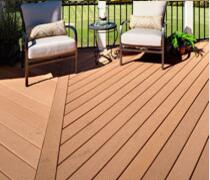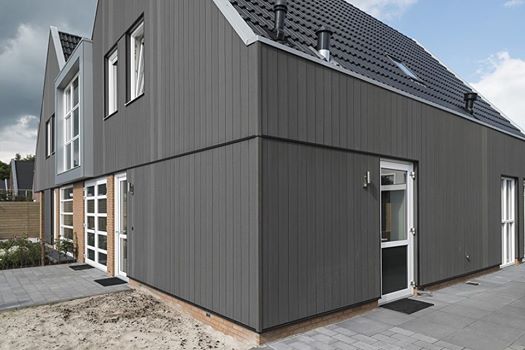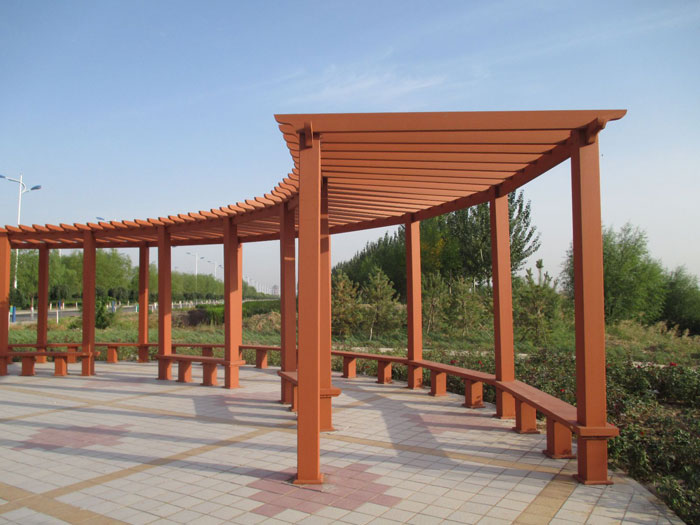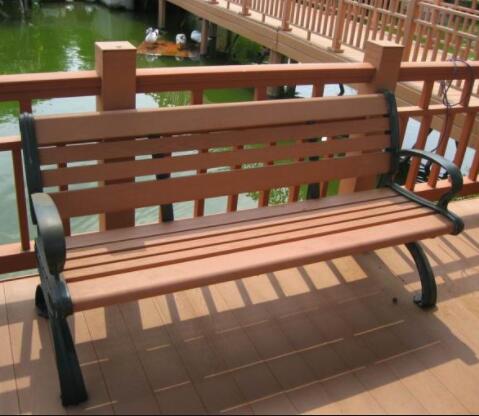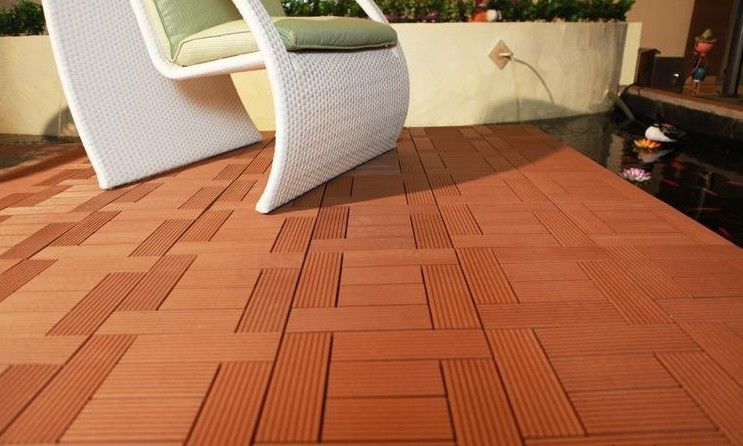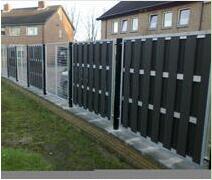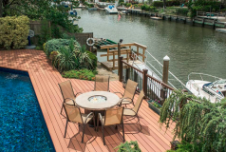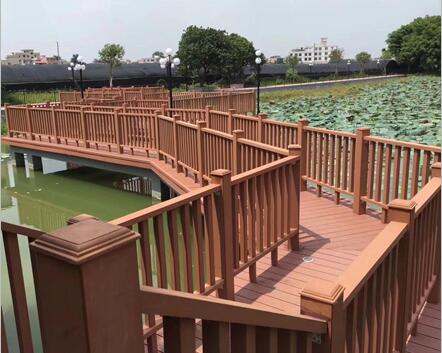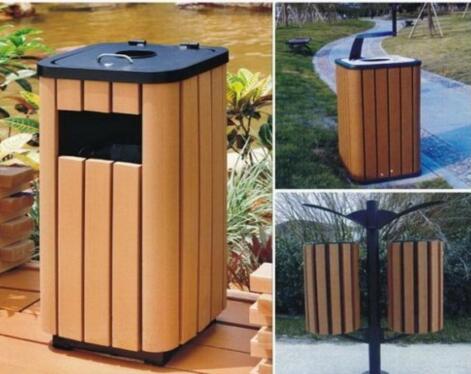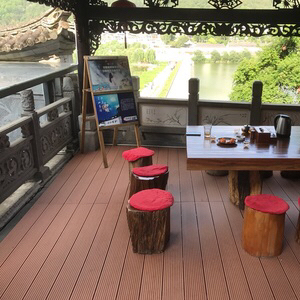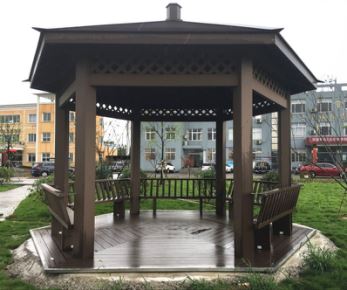Wood plastic composite (WPC) is a new kind of green environmental protection composite, and is the ideal substitute for wood. Waste wood and environmental pollution can be reduced.
This paper briefly introduces the plastic-wood materials, application fields, advantages and disadvantages, as well as the present situation of application at home and abroad, analyzes the development trend of wood-plastic composites, and confirms the necessity and feasibility of developing wood-plastic composites.
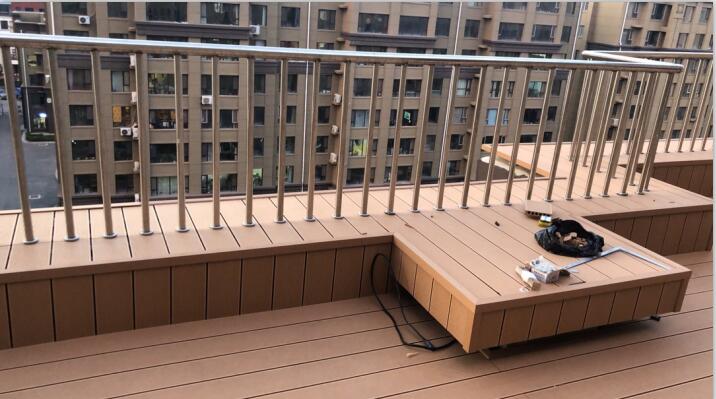
[keywords] Plastic-wood material plastic application field keyword] the development prospect 1, the plastic wood material brief introduction “the plastic wood material”, also called “the wood plastic composite material”, As the name implies, it can be understood as mainly using plastics as raw material, through adding wood powder, rice husk, straw and other waste plant fibers to mix into new wood materials, and then through extrusion, molding, injection molding and other plastic processing technology, the production of plates or profiles.
Mainly used in building materials, furniture, logistics packaging and other industries.
It is called extruded wood-plastic composite board that the plastic and wood powder are mixed in a certain proportion and then hot extruded.
The main ingredients of plastic wood are plastics and natural fibers.
Compared with the traditional wood, the biggest advantage of the plastic wood is the great contribution to the environment, saving wood is conducive to the protection of the ecological environment, there is no need for paint to avoid pollution to the environment, and recycling after waste can not produce secondary pollution.
Plastic wood products have the advantage of no paint, water-free, in about 10 years after the end of the life cycle, can also be recycled.
It is understood that plastic wood is mainly used for outdoor landscape and hydrophilic landscape, plastic wood service life is 3-10 times that of ordinary wood.
2. Wood / plastic composite is a new type of material which is composed of wood fiber or wood powder, thermoplastic resin and other materials.
The material has the following advantages: low water absorption, no deformation and cracking; low mechanical properties, light weight, moisture-proof, acid-alkali resistance, chemical resistance, salt and water resistance; no decay, easy cleaning; high processability, Sawing, planing, nail, easy to clean; can be used at low temperature; UV resistance; good mechanical properties, cheap, easy to process, recyclable; The main raw materials are widely used and can be recycled by 100%, which is in line with the industrial policy of sustainable development in China.
Wood plastic composite is a new kind of environment-friendly material with wide application and high added value. It is one of the main directions of the development of modern material industry.
3. Application fields of wood-plastic products: Wood-plastic composites not only have the formability of thermoplastic products, but also have the secondary processability similar to wood, such as cutting, bonding, painting, and has the advantages of insect resistance, aging resistance, water absorption and reusability, so they should be widely used in various fields.
1.1 the most widely used wood-plastic composites in the packaging industry are pallets.
There are more than 200 million pallets in North America and 6 million pallets in Japan, among which wood-plastic pallets account for nearly half of the market.
China Federation of Logistics and Purchasing Tray Professionals predicted that in recent years, the average use of wood trays in China will exceed 8000 thousand per year, and wood-plastic trays will occupy a certain market share.
1.2 Railway sleeper
At present, wood-plastic composite railway sleeper is not used much because of its high cost, but it is very promising.
How to further reduce the cost has become the key to popularize the application.
1.3 Wood-plastic composites in the construction industry are mainly used as gallery panels, windows and door panels, concrete forms, etc. Among them, the most rapid development is the corridor panels.
Although the gallery board is more expensive than the pressurized wood, it does not require much maintenance, is not easy to crack, and has good environmental compatibility.
Building doors and windows is another important application field, wood-plastic profiles in heat insulation, corrosion protection, decoration and other aspects are superior to traditional building materials.
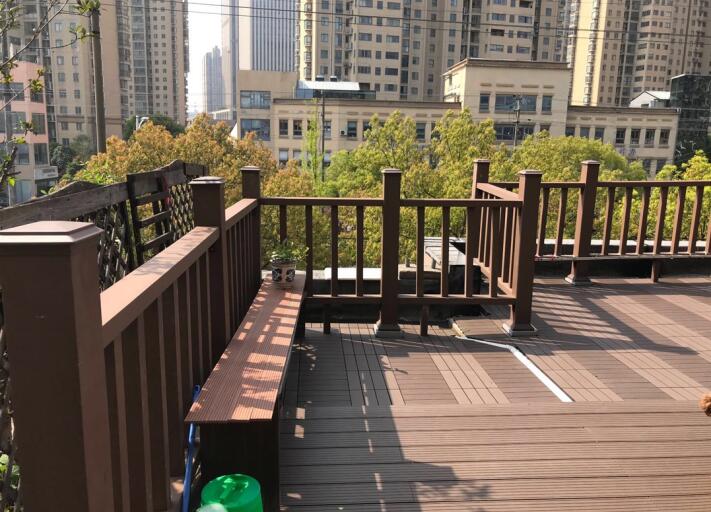
PVC is the most commonly used thermoplastic material for the production of window components, as well as other plastic materials. For example, Certain-teed extrudes the core of PVC together with the PVC surface filled with wood. The surface layer of the product can be coated or dyed. The wood-plastic doors and windows produced by a domestic wood-plastic door and window enterprise adopt ACR modified PVC and advanced international soft and hard composite plastic extrusion technology. The products fully embody the advantages of wood and plastic materials.
1.4 Gardens are mainly used in the manufacture of outdoor tables and chairs, yard armrests and decorative panels, open-air floors, waste containers, etc.
1.5 for the interior decoration of motor vehicles, the interior decorative substrates of famous brand sedans such as “Ford” in the United States, “Benz” in Germany, “Audi”, “BMW” in Japan, “Toyota” in Japan, “Citroen” in France and “Volvo” in Sweden, All in varying degrees of plumber to make use of wood-plastic composite materials.
Judging from the car parts products introduced by the International Automobile Expo in recent years, the wood-plastic composite materials are used to manufacture the substrates for the interior decoration parts of cars. It has been 16 years of history from laboratory to industrialization in North America.
Is the largest market in the world, the United States in R & D and market development has been in the forefront.
Global production in 2000 was 180000 tons and 400000 tons in 2001. Sales of plastic wood in North America reached $845 million in 2005, and 1 million tons in 2006 increased to $1.052 billion in 2010.
Trex, the largest plastic wood composite factory in the United States, produced 380000 tons in 2007 and is expected to grow at an annual rate of more than 15-25 percent over the next few years.
In Europe, the growth of wood-plastic composites is strong, the technology has reached the stage of co-extrusion, in the furniture manufacturing industry, has maintained a sustained growth, is about to take the lead.
In addition, Japan’s development is also in the international leading level.
5, the development history and present situation of domestic wood-plastic industry, with the improvement of people’s living standard, civilization degree and environmental protection consciousness, plastic wood should be used more and more widely at home and abroad, and the market prospect is wider and wider.
With the encouragement of the national circular economy policy and the potential benefit demand of enterprises, the domestic wood-plastic industry has not been developed for less than 10 years.
Up to 2005, there are about 150 wood-plastic enterprises in China. Most of these enterprises lag behind in technical level and are still in the initial stage of wood-plastic industry.
Up to the end of 2009, the domestic concentration in the wood-plastic industry chain of mainstream enterprises have reached more than 300.
It is especially important that, with the joint efforts of all parties, the manufacturing level of domestic wood-plastic materials / products has leapt to the forefront of the world and gained the right of equal dialogue with the wood-plastic enterprises of Europe and the United States.
With the vigorous promotion and the social concept renewal, the wood plastic industry will grow older and hotter.
Tens of thousands of people are employed in the wood-plastic industry in China. The annual production and sales of wood-plastic products have reached 100000 tons and the annual output value is more than 800 million RMB.
Wood and plastic enterprises are concentrated in the Pearl River Delta and the Yangtze Triangle region, far more than the east, the west.
The eastern individual enterprise craft level is more leading, the southern enterprise occupies the product quantity and the market absolute superiority.
The test samples of the important science and technology representative enterprises in the industry have reached or exceeded the advanced level of the world.
Large companies and multinational groups outside the industry are also closely watching developments in China’s woodwork industry. During the 2008 Olympic Games, the Olympic Park also purchased thousands of tons of wood and plastic products to build walkways and chairs.
For every ton of plastic wood products used, it is equivalent to reducing the waste plastic by 60,000.
The pollution of feeding bags is equivalent to cutting down 1.5 eucalyptus trees aged 30 years, which has profound environmental significance.

The public facilities of the 2008 Olympic Games have been used in a large area of wood and plastic products. The 2010 Shanghai World Expo is undoubtedly the most eye-catching China Pavilion. The “crown of the Orient” resembling an ancient hat is in a positive red color. In response to this, the pavilion is surrounded by a large area of mahogany floors, decorated with the Expo China Pavilion, and the 2010 Guangzhou Asian Games are also in place. In the active selection of this material, the 2011 Shenzhen Universiade and some public facilities, garden construction, logistics and railway construction are considering the use of large areas of plastic-wood composite materials.
6. According to the characteristics of plastic-wood composites, we can draw the following conclusions: 1. Plastic wood can replace or partly replace wood.
2, the forest volume of our country only accounts for 2.9% of the world, which is far from meeting the needs of 22% of the world’s population.
There is an urgent need for a product to replace the use of wood.
3. With the rapid development of our economy, the demand for forest products is increasing, and the supply and demand are becoming more and more prominent.
At present, the world consumes 0.58 cubic meters of wood per person per year, while China consumes only 0.29 cubic meters of wood per year. The annual demand for trees and their products in China is more than 300 million cubic meters, but the annual reasonable supply of existing forest resources is only about 60% of the demand.
4. On the other hand, in the next five to 10 years, the national population will increase by an average of about 11 million a year, and the economy will increase by more than 7 percent a year. This puts forward a higher demand for already poor wood, and a product is urgently needed to replace timber. And the fact proves, only plastic wood belongs to.
5. The world is short of timber, Australia and the United States have a self-sufficiency rate of 90 percent, our country’s self-sufficiency rate is 35 percent, Japan’s self-sufficiency rate is less than 20 percent, and the timber imports top three in the world are the United States, China and Japan.
Our country needs more substitutes for wood.
At present, the domestic demand for timber has reached more than 3-3.3 billion cubic meters. According to the national quota of forest cutting during the 10th Five-Year Plan period, it can only be 140 to 150 million cubic meters per year, which means that our country is still short of 150 to 1.6 million cubic meters per year.
7. Suppose that in the current wood gap of 150 to 1.6 million cubic meters in China, 3- 5 percent of the plastic wood is used instead, then the amount of domestic plastic and wood materials should be around 450-7.5 million tons. At present, the actual production capacity of plastic wood in China is only about 200000 tons.
We might as well consider carefully and measure that, of the 150 to 16 million cubic meters of wood in our country, through our efforts, the support of the sector, and the publicity of the whole society for the comprehensive use of resources, let’s assume that only 10 to 15 percent of the plastic wood is used to replace wood. What will the future of our wood industry look like? With the rapid adjustment of the industrial structure of plastic products industry in China, as one of the direction of structural adjustment, the recycling and reuse of waste plastics has become the key of the whole recycling industry chain. Moreover, the technology content of the whole industry is relatively high at present. A link in which profits are higher.
At present, the recycling rate of waste plastic and its packaging in China is less than 10%, while in Japan it has reached 26%.
According to the statistics of British economists, the current recycling efficiency of urban garbage in the United States has reached 32 percent, while in Austria, the Netherlands and other European countries, the recycling efficiency is more than 60 percent, while in Britain it is 27 percent.
WRAP calculates that waste recycling in the UK reduces carbon dioxide emissions by 10 to 15 million tons a year.
In 2005, recycling efforts reduced U. S. carbon dioxide emissions by 49 million tonnes.
In some developed countries, the development and research of recycling and utilization of waste plastics started early, many technologies have matured gradually, and have produced very good benefits.
In our country, waste plastic recovery industry is a positive environmental protection industry, development potential is great.
From the point of view of the technology of recycling waste plastics, the value of waste plastic products, including plastic and wood compounding, is mainly improved in several ways.
Manufacturing building materials, sundry goods, chemical products, geotechnical materials, etc.
In the above fields, the building materials made from waste PVC and polystyrene have the advantages of moisture-proof, anticorrosion, sound insulation and non-deterioration. They are used to make riverbank and lakeside bank protection, doors and windows, wall (core) partitions, etc. Substitute wood and cement, is an important direction for the future development of the entire industry.
Low carbon environmental protection (WPC) is a new type of environmental protection material which has been respected and developed rapidly in the world since 21 century.
It is made from waste plastics such as polypropylene (PP), polyethylene (PE), polyvinyl chloride (PVC) and other agricultural and forestry wastes such as sawn wood straw rice husk corn stalk etc. The proportion of waste in raw materials can be as high as 90, in line with the national energy-saving and environmental policy-oriented.
Because of the dual properties of wood and plastics, plastic wood materials overcome the shortcomings of high water absorption, easy deformation and cracking, easy to be moldy by insects, high mechanical properties, light weight, moisture-proof, acid and alkali resistance and corrosion resistance. It can be used in many fields instead of logs, plastics and aluminum alloys. It is a new generation of energy saving and environmental protection products that will replace traditional wood in the future. At present, the price of a square meter of plastic wood flooring on the market is 200-300 yuan. Higher than the solid wood floor, this is because the specific gravity of wood is much higher than wood.
When so, want to replace logs in the market as soon as possible, plastic wood first to achieve “self-reduction price.”
From the overall form, plastic wood into the interior decoration industry is still in its infancy, first of all, we must change the technology, reduce the cost; in addition, we also need to re-establish sales channels to promote the market, will certainly have a good prospect.
In a word, the development prospect of plastic wood industry is not only good in China, but also good in the world.
This is not only due to the excellent characteristics of the product itself, but also to the significance of the recycling of its resources and its important contribution to environmental protection.
As an ideal environment-friendly material, plastic-wood composite materials have low cost and can be reused and recycled, so they are gradually replacing some products that pollute the environment.
At the same time, we should realize that as a new material, it is not omnipotent to have enough understanding and confidence in the excellent properties of plastic wood products.
Only our correct understanding, scientific and rational use, in order to promote the healthy and vigorous development of the industry.
If you are interested in WPC products from China, welcome send us the inquiries by Email.


